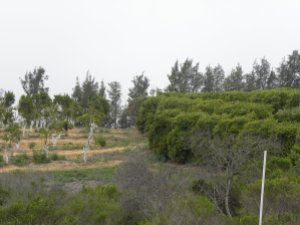“What’s going on with those trees?” That question runs through the minds of the causal observer and the agricultural enthusiasts who drive by the citrus tree grove operated by the Ikeda family off Lopez Drive in Arroyo Grande, CA – Neighbors to Grieb Ranch. Sections of rows of citrus trees have been pruned back to three or four main branches, with one branch reaching to the sky, and a trunk that is painted white. These trees are in stark contrast to the lush full sections of orange trees that have been part of the citrus grove for 25-30 years. The resulting “trees” do not look much like trees at all, more like an orchard of giraffes.

Brysen Ikeda in the becoming-lemon grove.
Brysen Ikeda works this grove and has answers to what they are doing to those trees. The short answer from Brysen is, “We’re changing the orange trees to lemon trees.” The reason behind the effort is market demand. The demand for lemons is year round. The packing house, Bee Sweet Citrus – where the Ikeda family sells their fruit through – is located in the San Joaquin Valley. The citrus growers in the valley, due to the climate, can only grow one crop of lemons a year. Here on the coast the moderate climate, combined with the right variety of lemon (Eureka and Lisbon), can produce lemons year round. “Our trees can set fruit 4 or 5 times a year. The lemon tree varieties we choose are constantly flowering and blooming to grow fruit year round,” remarked Brysen.
So why not just pull the orange trees and plant lemon trees? The difference is time for the tree to produce fruit. A new bare-root lemon tree will set fruit in 4 years compared to a grafted tree that will set fruit in 18 months. So that is what the Ikeda family is doing; converting 25 acres of orange trees into lemon trees. They are leaving 35 acres of orange trees and have 10 existing acres of lemon trees presently in this location. The Ikeda family currently has 4 generations of vegetable row crop farmers farming in the Arroyo Grande area where the family has worked the land for decades. Citrus is a new venture for the Ikeda family and Brysen spearheads the citrus operation, learning much about citrus as he goes about this conversion process.
Just how does an orange tree become a lemon tree? First the orange tree is pruned back to three main branches plus one reaching to the sky as the “nurse” branch. This promotes growth response in tree, as it sends its energy and sap flow up to feed the 3 main branches. Near the top of the branches that stop short two vertical notches are cut into the tree. A lemon bud is then inserted into the vertical notch as a graft. If the nurse branch is one of the remaining branches used for the lemon grafts, a horizontal cut is made above the lemon grafts to pool the tree’s sap and energy at the lemon grafts, instead of going up the limb to the oranges. The orange tree will continue to put out orange branch suckers which need to be knocked off so that only the lemon grafts will become new branches.
About a year after the lemon grafts are inserted the nurse limb will be cut off. The lemon tree grafts will then be cut back to 6 or 7 leaves of eyes to produce thicker growth and the top of the remaining limbs above the lemon grafts will be cut back to encourage the lemon branches to grow up and out. Because the tree no longer has the protection of its foliage the tree trunk is painted white to protect it from sun exposure. However in time, as the trees continue to grow and the lemon grafts take on their new life as lemon tree branches attached to an orange tree trunk, a beautiful grove of citrus trees producing lemons throughout the year will be present.






